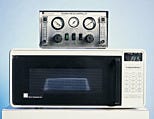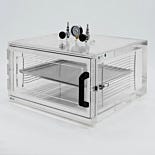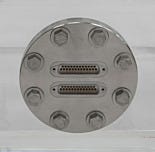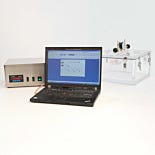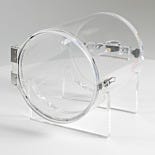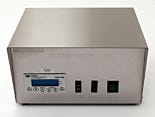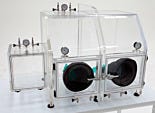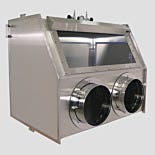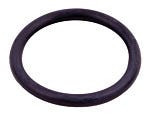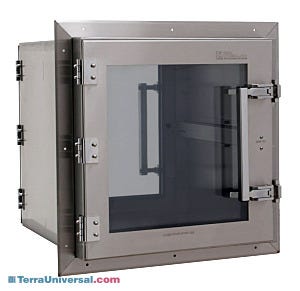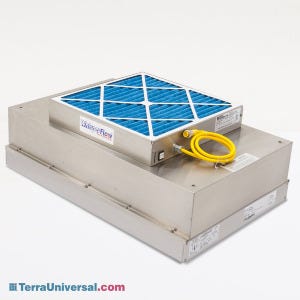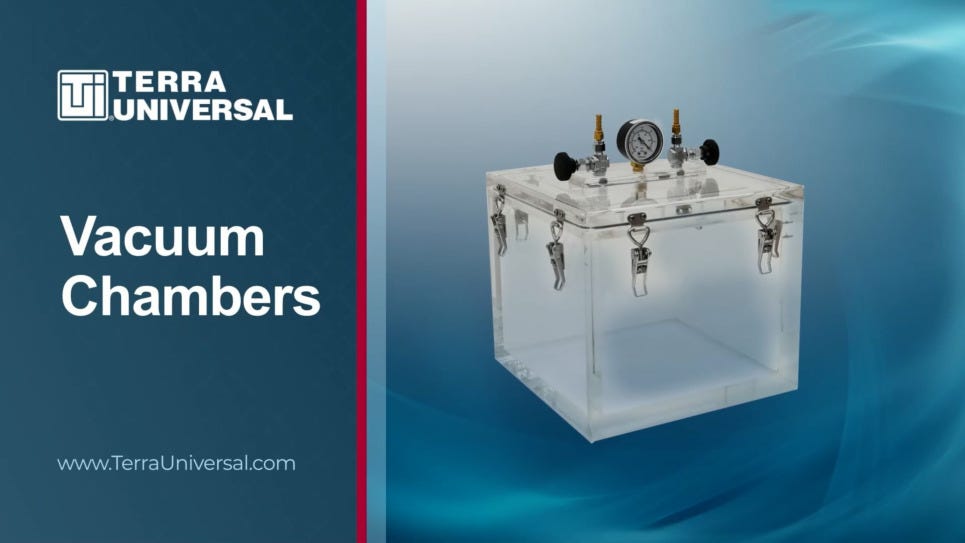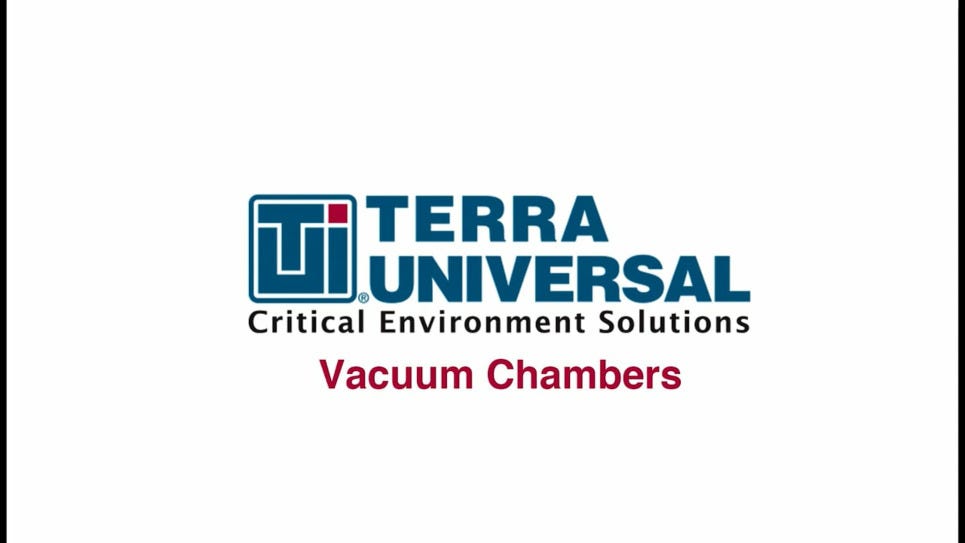Vacuum Chamber FAQ
What is a vacuum chamber and how is it used?
A vacuum chamber is a rigid enclosure designed to maintain a low-pressure environment, including full vacuum equivalent to outer space. Vacuum chambers require a vacuum pump to remove air and other gasses from the chamber in order to achieve a vacuum environment.
Vacuum chambers have countless applications such as manufacturing, quality testing, experimentation and research. Common manufacturing processes include vacuum coating, degassing, and vacuum drying. Semiconductor manufacturers use vacuum chambers to perform dye and pry tests, as part of the failure analysis process to identify hidden defects in electronic components. Examples of quality testing include package integrity testing (e.g. bubble leak testing) and electronic equipment testing. Vacuum chambers are also popular in lab experiments and research applications such as altitude simulation, physics and nuclear research.
What is permeation vs outgassing, and how does it affect a vacuum chamber?
Permeation refers to the flow of air/moisture from the outside through the walls of the vacuum chamber, which slowly diminishes vacuum. Outgassing is the release of chemical gasses, moisture, and air from the wall material itself which also diminishes vacuum and can contaminate the vacuum system.
Plexiglass acrylic, also known as polymethyl methacrylate (PMMA) can permeate and outgas. The thermoplastic’s amorphous (non-crystalline) configuration is a random arrangement of polymer chains. This creates microscopic pores where moisture and air can absorb and pass through, albeit in small amounts. By comparison, austenitic 304/316 stainless steel is a highly-ordered crystalline structure and therefore does not absorb or “hold” water vapor at a macro level.
The effects of permeation and outgassing for both acrylic and stainless steel are generally not a significant problem in the low to medium vacuum ranges mentioned below. These factors are more critical for reaching ultra high vacuum (UHV) and extreme high vacuum (XHV) ranges. Stainless steel is also recommended for applications that are sensitive to moisture permeation and outgassing.
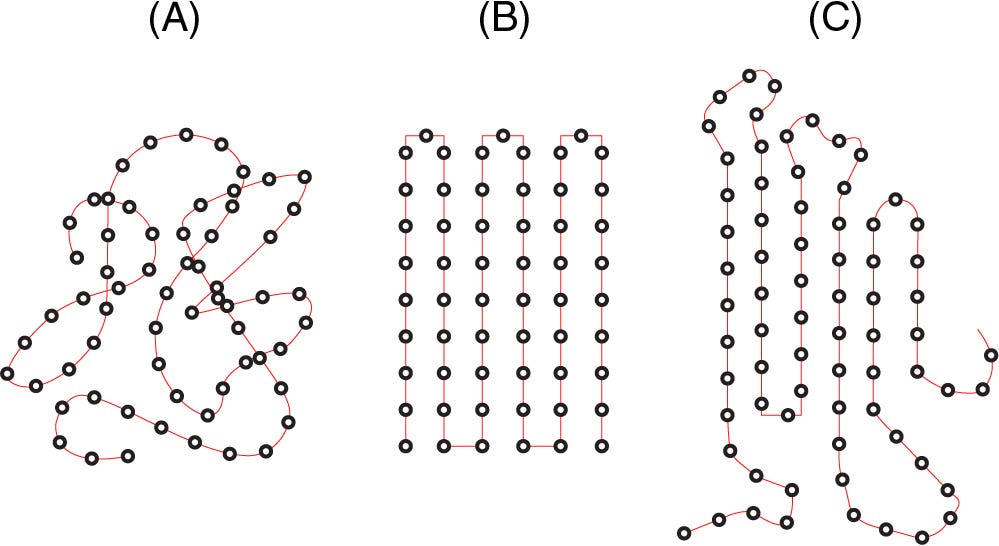
Crystal structures: (A) amorphous, (B) pure crystalline, (C) semi-crystalline
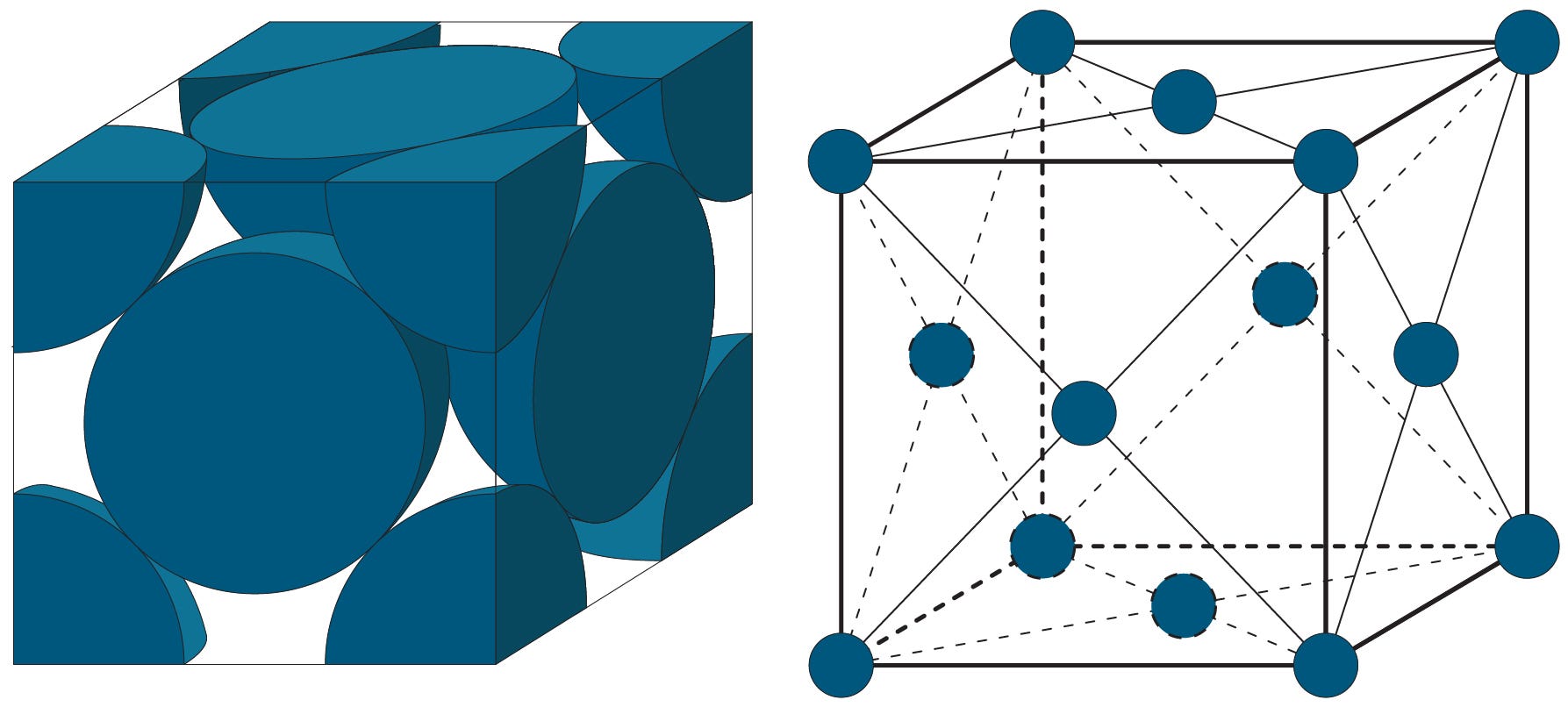
Austenitic Steel (300 series stainless steel) has a close-packed Face Centered Cubic (FCC) crystalline structure.
What is the difference between LV, MV, HV, UHV, and XHV?
These acronyms stand for the different ranges of vacuum, XHV being associated with the highest level of vacuum found in outer-space. It is important to note the lowest vacuum any chamber can achieve is dependent on the vacuum pump used with the vacuum chamber system. Most rotary vane pumps and diaphragm vacuum pumps are capable of operating in the “rough vacuum” LV - MV range which is suitable for most commercial, industrial, and research applications. HV, UHV, and XHV ranges generally require non-permeable and non-outgassing walls to sustain the higher levels of vacuum. Since plastic vacuum chambers are permeable and outgas, they are generally not suitable for HV - XHV ranges.
| Classification | Vacuum Level | ||
|---|---|---|---|
| mbar | Pa | Torr | |
| Low Vacuum (LV) | 1.33 to 1.33x10-3 | 133.3 to 1.33x10-1 | 1 to 1x10-3 |
| Medium Vacuum (MV) | <1.33x10-3 to 1.33x10-5 | <1.33x10-1 to 1.33x10-3 | <1x10-3 to 10-5 |
| High Vacuum (HV) | <1.33x10-5 to 1.33x10-8 | <1.33x10-3 to 1.33x10-6 | <1x10-5 to 10-8 |
| Ultra-High Vacuum (UHV) | <1x10-8 to 1x10-12 | <1x10-6 to 1x10-8 | 7.5x10-9 to 7.5x10-13 |
| Extreme High Vacuum (XHV) | <1x10-12 | <1x10-10 | <7.5x10-13 |
What is the best material for my vacuum chamber application?
The material used to build a vacuum chamber must be rigid and support other required conditions for your application. Here are some characteristics to keep in mind when choosing a material to best fit your vacuum chamber application:
- Cost
- Level of vacuum
- Chemical resistance
- Thermal extremes
- Visibility
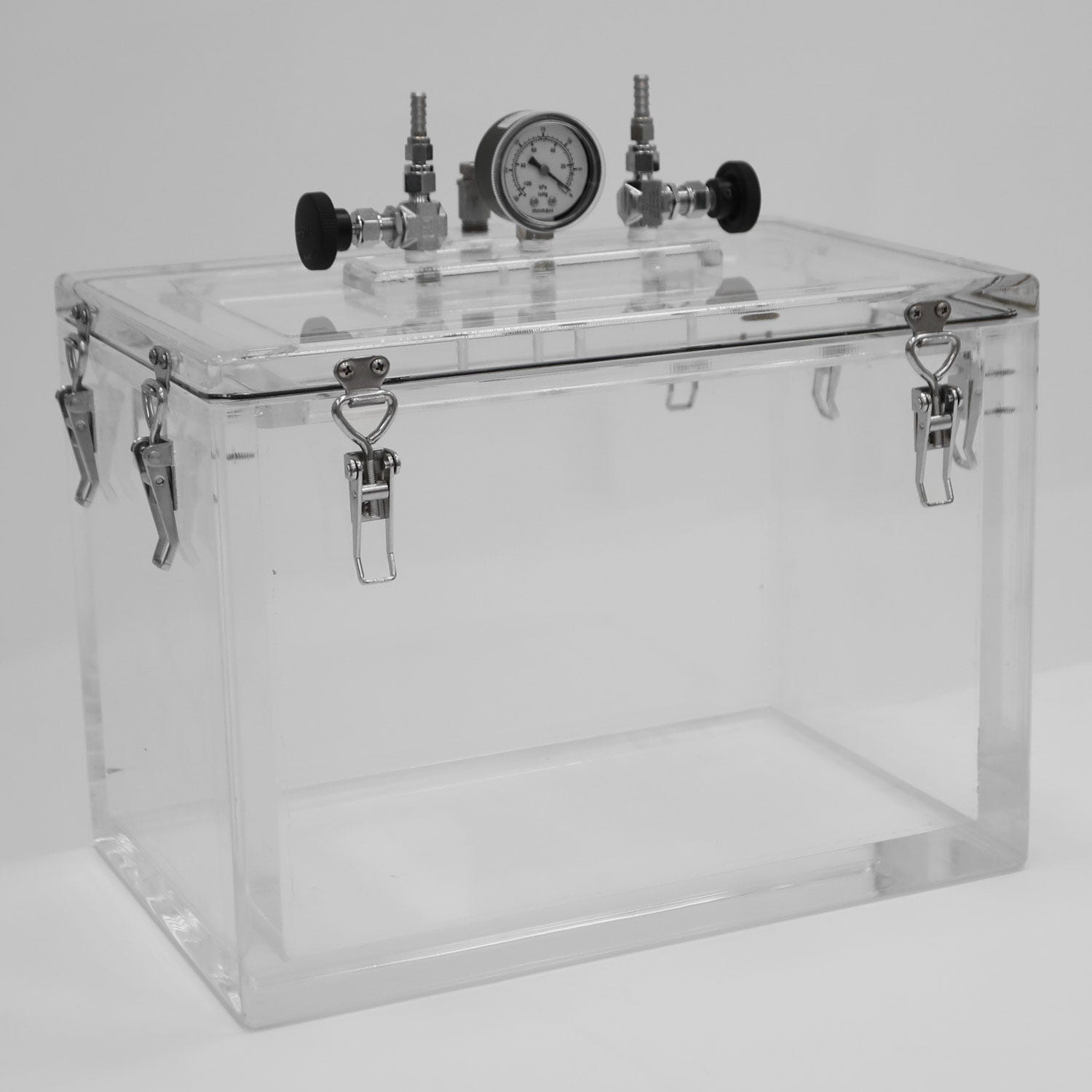
A plastic vacuum chamber generally offers the lowest cost and best visibility, making them ideal for most manufacturing, testing, and research applications. Terra offers plastic vacuum chambers made of 1” thick solvent-welded acrylic (plexiglass). Although lower cost than aluminum or stainless steel, these plexiglass vacuum chambers have the least chemical resistance and lowest compatibility for temperature extremes. Plastic walls are also permeable (vacuum pressure will diminish over time) and outgas (possibly contaminate the vacuum system depending on your application).
Due to permeation and outgassing, acrylic vacuum chambers lose vacuum pressure initially via air released from acrylic walls during the first few hours. After full vacuum (29.9"Hg) is restored following this initial drop in vacuum pressure, chambers are tested to hold 29.9"Hg with no detectable change in pressure over a 72 hour duration.
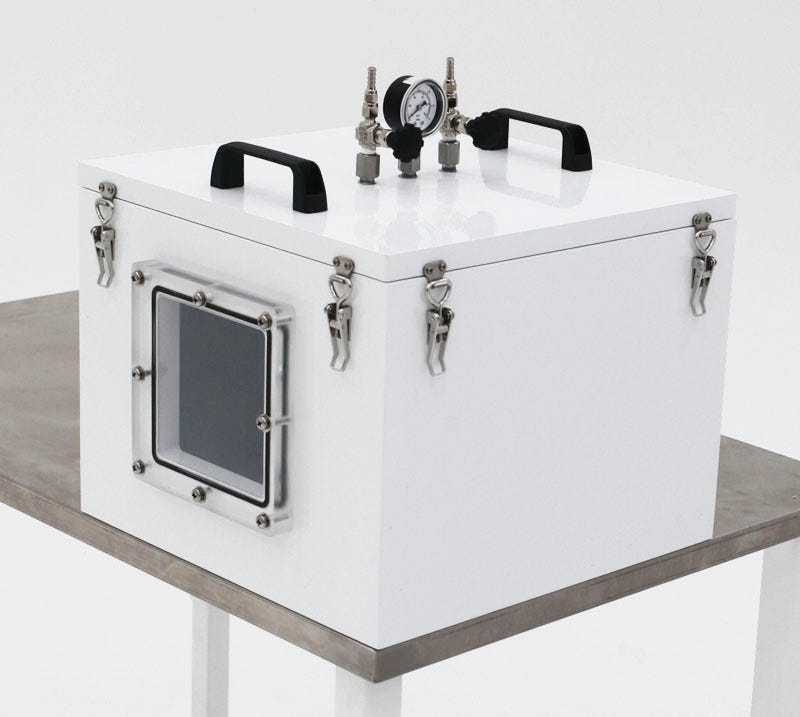
Aluminum vacuum chambers permeate and outgas the least compared to acrylic and stainless steel, providing a cleaner environment and higher level of vacuum for a longer period of time. It is roughly a third the weight of stainless steel, making it a lower cost option compared to a similar stainless steel design. Aluminum also has higher thermal conductivity and is non-magnetic which can make it useful for applications such as electron optics.
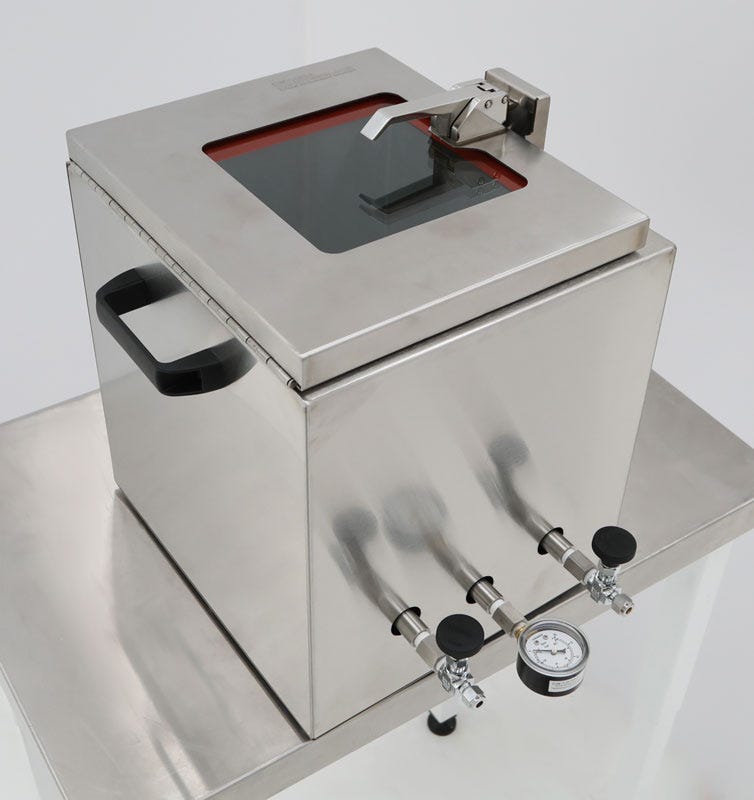
Terra’s stainless steel vacuum chambers offer a range of benefits comparable to aluminum designs. Similar to aluminum, stainless steel outgasses less than acrylic, has higher chemical resistance, and is suitable for higher temperature applications. Unlike aluminum vacuum chambers, these stainless steel vacuum chambers can be constructed with double-wall 304 stainless steel sheet metal, as opposed to 1” solid walls. This provides a rigid yet lightweight design for easy transportation.
What is the difference between a box and cylinder shaped vacuum chamber?
Vacuum chambers can be built in countless shapes and sizes. The standard designs include sphere, cylinder, and box. In theory, sphere’s offer the best rigidity and least amount of material, followed by cylinders, and lastly boxes. While all 3 shapes can reach full vacuum, there are a number of reasons to consider a box or cylinder shape. In most cases, the size and orientation of part(s) fitting inside the chamber, plus your application should determine what type of design to consider.
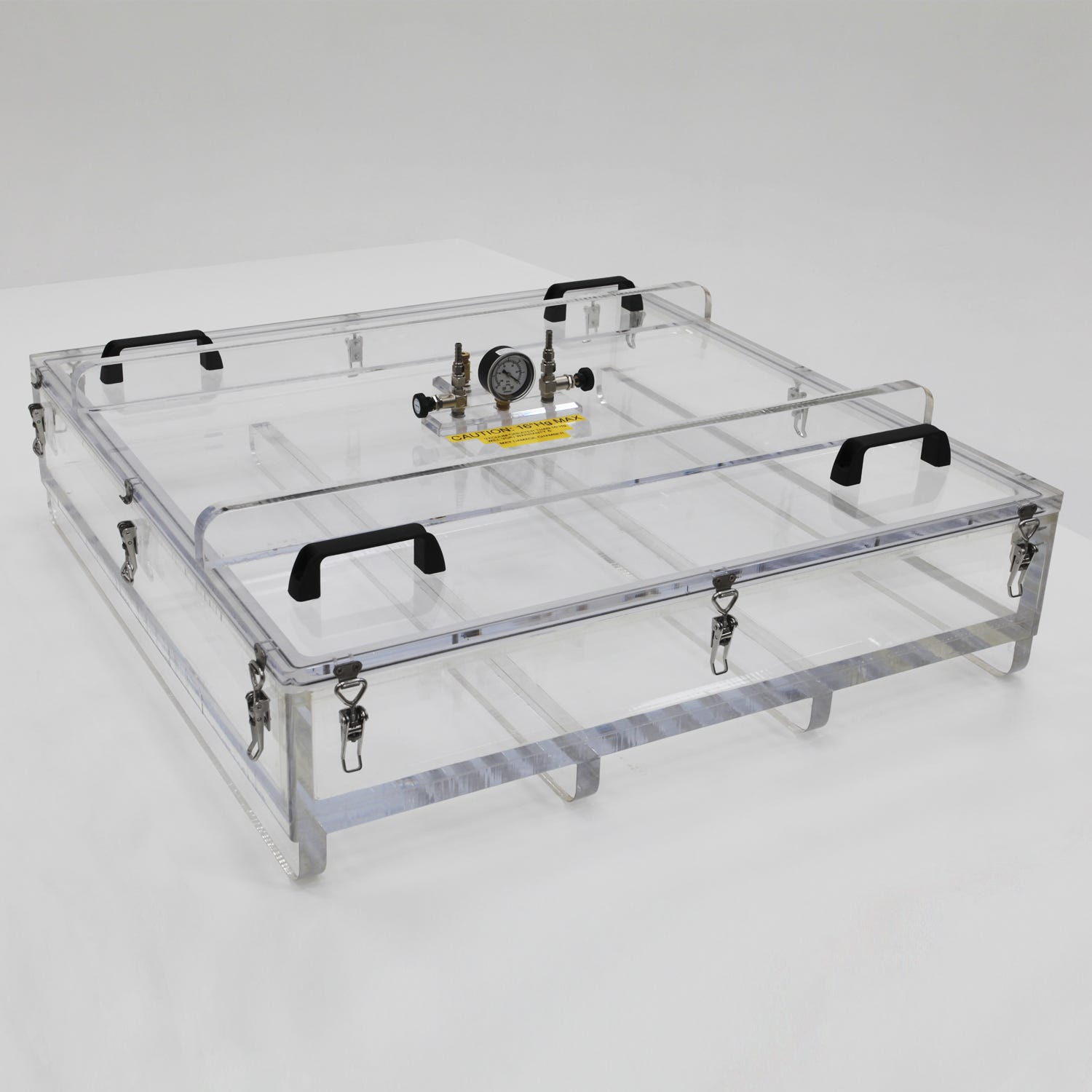
A box vacuum chamber offers a number of benefits over the other designs. The rectangular shape provides the most flexibility for odd shaped applications. For instance, to fit a part that is very long and wide but short (a large flat sheet, for example). Box shapes can also have data feedthroughs easily installed on all sides. In addition, the flat transparent walls are ideal for applications that require clear visibility. Flat walls minimize distortion of light, which makes it easier to see the true shapes of stored materials without opening the chamber. Box vacuum chambers can also be built like a storage cabinet to offer quick access for repetitive batch processing.
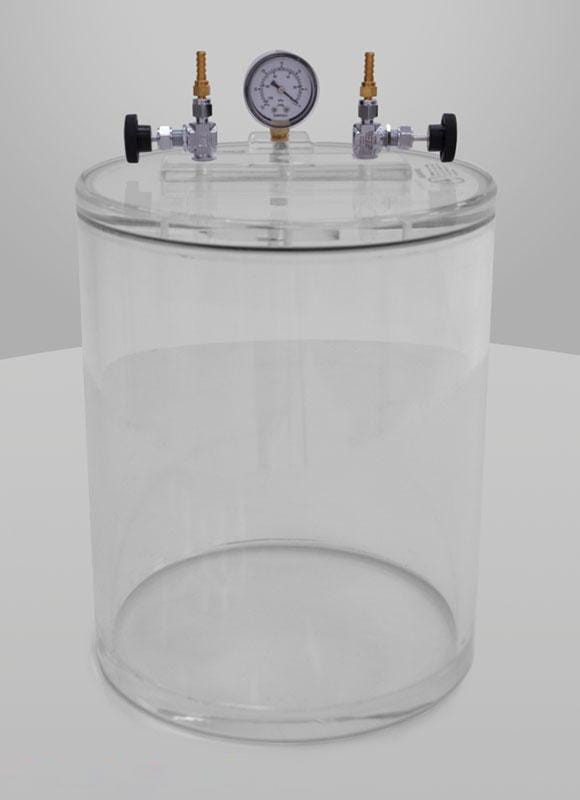
Basic cylinder vacuum chambers can be a lower cost option compared to similar box sizes. This is because cylinder designs typically have less corners and edges to weld compared with a box shape. Cylindrical shapes in theory are also more rigid than boxes, so they can have thinner walls compared to a box of roughly the same size. Cylinders are also more suitable to fit long, narrow components (for example tall rod shaped parts).
What is the benefit of a box vacuum chamber with a front swinging door versus one with a removable top lid?
Vacuum chambers with removable top lids are generally lower cost, but may not be the most space efficient depending on your application. They may be suitable for parts that require access from the top of the chamber, but may be awkward for parts or processes that require frequent side access. Vacuum chambers with front swinging doors can provide faster batch processing. First, the swing door allows for quick access and easy transfer of parts. A vacuum chamber with removable top lid requires the part to be lifted vertically above the chamber, which might be challenging for large, sensitive, and expensive parts. Second, vacuum chambers with front swinging doors can be fitted with shelves to mimic a storage cabinet for greater space efficiency.
How do you measure temperature and humidity inside a vacuum chamber?
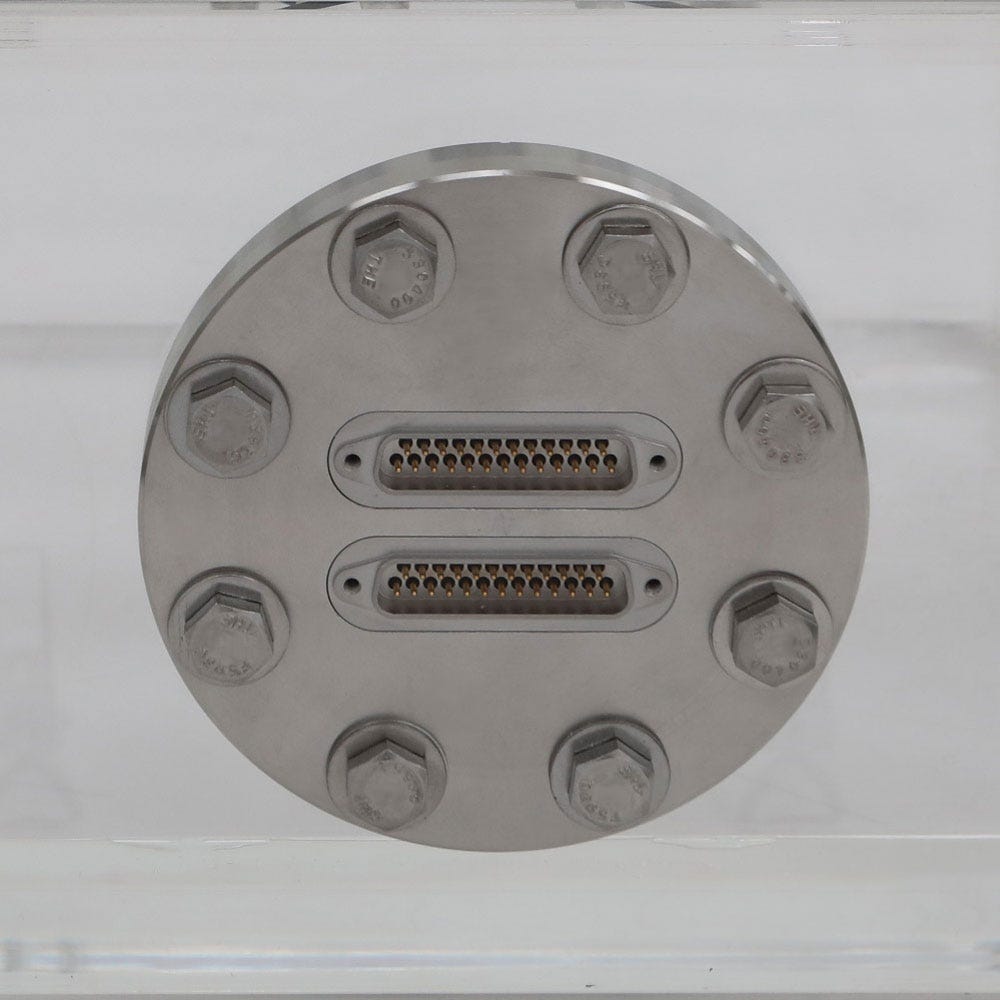
You can specify the installation of feedthroughs in the vacuum chamber walls to measure conditions and power equipment inside the chamber. Vacuum chamber feedthroughs come in many different styles and configurations, but installation is generally the same. If you choose to customize your vacuum chamber, you can select the feedthroughs you require and we will install them for you.
For temperature readings, you can specify thermocouple feedthroughs either as a single probe or multi-pin configurations. Feedthroughs can also pass wires and small-bore tubes into the vacuum chamber for humidity sensors and similar components.
Can you use Terra Universal vacuum chambers for degassing?
Yes, but it depends on the chemicals involved in your degassing process. Be sure to verify chemical compatibility.
Terra’s vacuum chambers include all of the necessary components for vacuum degassing, including inlet/outlet hose fittings and a pressure gauge. An adjustable automatic relief valve can be added as a safety precaution against pulling too much vacuum.
How do you lower the relative humidity level inside a vacuum chamber?
After evacuating the air from the vacuum chamber, you can backfill the chamber with nitrogen gas using the secondary inlet valve. The inert gas will help prevent oxidation and degradation of moisture-sensitive materials (such as electronics or powders).
You may need to perform multiple evacuation/backfill cycles to achieve the lowest possible humidity. Welded aluminum or steel chambers will provide better long-term protection against moisture. Acrylic chambers are more permeable than metal chambers, which means moisture will gradually return through the walls of an acrylic chamber.
How do you simulate different altitudes inside a vacuum chamber?
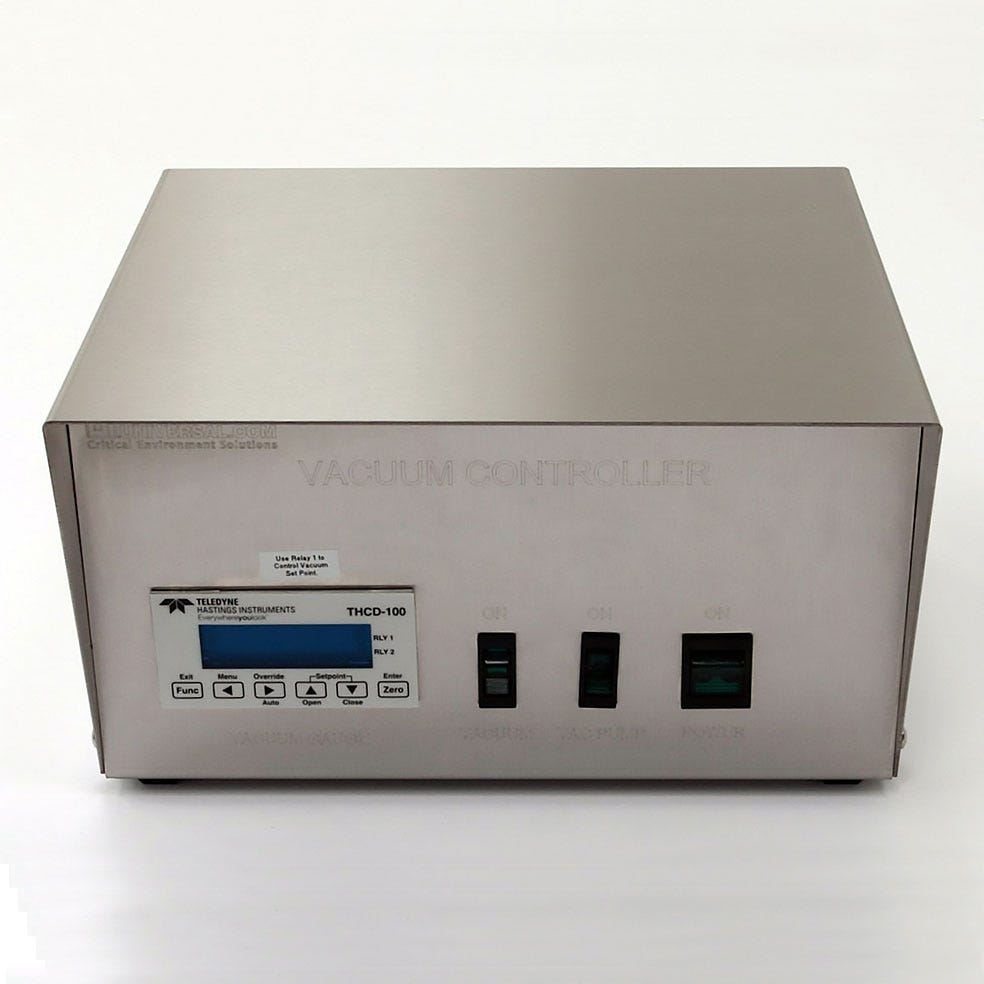
A vacuum pump controller will be required to target specific atmospheric pressures (besides full vacuum). When the chamber reaches the desired pressure, the vacuum controller will cut off the vacuum line using a solenoid valve. The controller can also be used to maintain pressure levels for a period of time (by reapplying vacuum) and more advanced controllers can be programmed to run a series of simulations.
With a vacuum controller, the lab vacuum pump can be left on throughout the simulations, which reduces wear-and-tear on the pump motor and seals.
Can you use solvents/reagents inside a vacuum chamber?
Before using any chemical agent inside the vacuum chamber, you should check chemical compatibility with the chamber material, seals, windows and fittings. Solvents should not be used inside an acrylic vacuum chamber or in chambers with acrylic windows. In general, stainless steel vacuum chambers are resistant to most solvents and reagents.
How do you test packaging and hermetic seals with a vacuum chamber?
You can use an acrylic vacuum chamber to perform bubble leak testing. By submerging a packaged product in water and evacuating the air in the chamber, you can detect leaks by watching for any bubbles released from the packaging. The transparent walls of the acrylic vacuum chamber make it easy to observe the test from any angle. If your product may release corrosive materials during testing, you should opt for a metal vacuum chamber with a built-in window or glass top.
Can you use solvents/reagents inside a vacuum chamber?
Before using any chemical agent inside the vacuum chamber, you should check chemical compatibility with the chamber material, seals, windows and fittings. Solvents should not be used inside an acrylic vacuum chamber or in chambers with acrylic windows. In general, stainless steel vacuum chambers are resistant to most solvents and reagents.
How do you test packaging and hermetic seals with a vacuum chamber?
You can use an acrylic vacuum chamber to perform bubble leak testing. By submerging a packaged product in water and evacuating the air in the chamber, you can detect leaks by watching for any bubbles released from the packaging. The transparent walls of the acrylic vacuum chamber make it easy to observe the test from any angle. If your product may release corrosive materials during testing, you should opt for a metal vacuum chamber with a built-in window or glass top.
How do you clean a vacuum chamber?
Acrylic vacuum chambers should only be cleaned with water and mild detergents. Solvents will damage the acrylic.
Powder-coated aluminum chambers are more durable and can stand up to harsher cleaning agents, such as isopropyl alcohol. However, frequent cleanings with solvents will slowly degrade the finish. Water and mild detergents are recommended.
Stainless steel chambers can be safely cleaned with most solvents. Avoid using bleach solutions, which can oxidize and damage the stainless steel surface.
Can't find what you're looking for?Tell us what you need and we'll build it!





